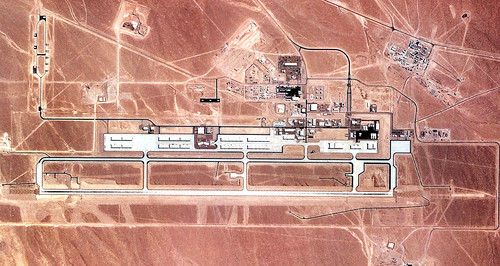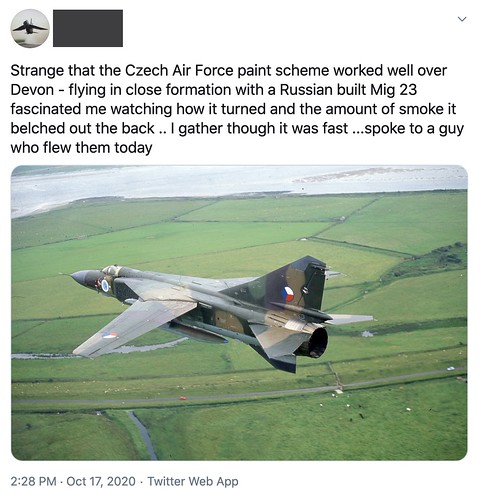An aviation photographer and writer I follow on Twitter posted this the other day:
I couldn’t resist commenting:
My response triggered questions, mostly from people wanting to know when, where, and how it happened. Not that many years ago I could have gotten in serious trouble for even confessing to flying against a MiG, never mind sharing the details.
One of the aviation writers who participated in the discussion prompted me to tell the story on my blog. I’m flattered to learn a working aviation writer and journalist — someone who actually gets paid to do it — knows about my blog, but in fact I have told part of the story here. This is from a post I wrote in 2018:
In my day the USAF ran a super-secret program (finally declassified in 2006, which is why I can write about it now) called Constant Peg from an airstrip near Tonopah, Nevada, where it had a small squadron of MiG-21 Fishbeds and MiG-23 Floggers. Aircrews at Nellis AFB’s Fighter Weapons School, along with visiting aircrews taking part in Red Flag air war exercises, were able to go out in ones and twos to engage with the MiGs over Tonopah. It wasn’t adversary training, not really … it was a familiarization program, as in “here’s what a MiG looks like in the air, here’s how it flies and fights, here are its strengths and weaknesses” … the idea being to get the buck fever out of your system before you saw the real thing in combat. Great training, but strictly limited (as in you only got to do it once), rigidly scripted, nothing like actual air combat.
Here’s the rest of the story, as I remember it.
During my first two F-15 assignments, from 1978 to 1985, I frequently trained with and flew against USAF aggressor pilots trained in Soviet tactics and equipped with F-5E Tigers, roughly equivalent in size and performance to the MiG-21 Fishbed, which at the time was still one of the other side’s front-line combat aircraft. I’d heard whispers about a program where USAF fighter pilots got to fly against actual MiGs, but that was the extent of it — bar talk and rumor.
In 1984, I deployed from Alaska to Nevada for a Red Flag exercise. It was there I was read in to the Constant Peg program and realized I was going to get to see the MiG-21 and MiG-23 in action. The program was highly classified, not so much due to the fact we had MiGs, but to conceal how we obtained them. We had to be formally read in before participating; afterward we were read out and warned never to talk about it, even with F-15 squadron mates.
The MiG pilots were assigned to a unit called the 4477th Test and Evaluation Squadron, the “Red Eagles.” They were experienced Air Force and Navy fighter pilots, a lot of them veterans of the F-5 Aggressor program, and many were “target arms” — Fighter Weapons School graduates. My Constant Peg flight consisted of me, a wingman, and two Red Eagle pilots — one flew the MiG-21, the other the MiG-23. We briefed at Nellis, three to four hours before our scheduled takeoff time. That allowed time for the MiG pilots to hop on their transport aircraft, a Mitsubishi MU-2, and fly uprange to the Tonopah Test Range airfield where the MiGs were based.

My wingman and I took off in our F-15s at the scheduled time, met a tanker over Caliente and topped off, and headed northwest to Tonopah. The MiG pilots monitored our progress on the radio, calibrating their takeoffs to give us maximum time with each. Which translated into the MiG-21 taking off just before we entered the working area over Tonopah and jumping us the second we did. We took turns dogfighting the Fishbed, which was (to me, anyway) surprisingly nimble and tight turning, hard to see due to its small size, and hard to get a guns tracking shot on. The Fishbed, if it uses afterburner (as ours did the entire time we fought with it) has enough gas to fly for about 20 minutes. It was a busy 20 minutes for both of us.

As the Fishbed turned back toward Tonopah, almost directly below us, the Flogger joined our our wing. We didn’t do as much turning and burning as we had with the Fishbed. The Flogger, as we’d been briefed, doesn’t turn for crap, and bleeds off energy quickly. Instead, our MiG-23 pilot showed us how it flies, which is as poorly as it fights: difficult to control and unstable, especially with the wings swept aft. What it could do well, as its pilot showed us, was make a high speed, high-angle attack and then run. It accelerated away from us like nothing I’ve seen before or since, driving home the point that if you have a missile shot at a no-shit fast mover you’d better take it right now, because in a second it’ll accelerate right out of the firing envelope, and I guess that was the object of the lesson. The F-15 has the top speed advantage, but there isn’t enough fuel in the world to catch up with a Flogger determined to get out of Dodge.

We did not land at Tonopah to debrief. The airfield was also home to the Black Jet, the F-117 stealth fighter-bomber, and everything there was classified to hell and gone, just like the airfield in nearby Area 51. Instead, we flew back to Nellis, followed a while later by our Red Eagle adversaries in their cushy little Mits.
One odd detail sticks in my memory. During the briefing and debriefing, I was distracted by the grotesquely long and curled pinky nail of our MiG-21 driver, apparently a fetish of his. In my Air Force, anything like that would have been a Be-No; apparently the Red Eagles had more freedom to indulge in personal eccentricities. Not sure why I’m sharing this memory, other than that it still gives me shivers.
I believe Red Eagle pilots were dual-qualified, meaning that they flew and maintained proficiency in two aircraft simultaneously. Holding dual qualifications was common in the USAF of the 1950s and 60s but was rare in my day. I can’t recall if their other aircraft was the F-5 Tiger or A-7 Corsair II (probably the latter, since it was the aircraft their Tonopah colleagues, the F-117 pilots, were dual-qualified in). Perhaps someone who knows can enlighten us in a comment. Of course a few of the Red Eagles were also current in the Mits, the MU-2 twin turboprop they flew back and forth between Nellis and Tonopah.
Well, those were the Reagan years, when budgets were fat and the military services could (and did) ask for the moon. The USAF had Constant Peg and three full-up F-5 Aggressor squadrons, one each in Europe, the Pacific, and CONUS. Imaging having all that, then asking Uncle Sam for a spiffy little business turboprop to get back and forth in — and getting it!
These programs ended, or were sharply curtailed, with the end of the Cold War. Constant Peg went away. The Aggressor squadrons were deactivated, eventually coming back in the form of what are today two small F-16 adversary training units, one at Nellis and one in Alaska, plus small contracts with civilian aggressors operating older foreign-built fighters (Hawker Hunters, Kfirs, and Mirages). With the post-Cold War integration of former Warsaw Pact nations into NATO, USAF pilots assigned to Europe have had limited opportunities to fly with, and train against, more modern Russian-built equipment. National air forces operating Russian aircraft now participate in Red Flag exercises at Nellis AFB. Training opportunities are there, but they are a far cry from what we had in the early 1980s.
I have to say, I think I got to fly the F-15 Eagle at precisely the right point in history, and will be forever grateful for the experience.
Links
- Air Force Magazine: Constant Peg (Apr 2007)
- National Museum of the USAF: Secret MiGs in the Desert (Nov 2018)
- Wikipedia: 4477th Test and Evaluation Squadron
- Wikipedia: Aggressor Squadron


A very interesting post Paul and despite your best efforts in telling what you can, I am sure there’s still more to come out.
It would be interesting to know not only if newer designs were were subject to similar intelligence exploitation, but also if other NATO allies had similar programs – or indeed if the Soviet Union aquired Western military designs for similar reasons.
Of course, we probably will never know…
A very interesting post Paul and despite your best efforts in telling what you can, I suspect that there’s more to emerge, not least about servicing these aircraft as well as keeping the aircraft hidden on a local level.
It would also be interesting to learn if newer ‘potential enemy’ designs were subject to similar intelligence exploitation – not just by the US – but by other NATO and Western air forces.
But I guess the REAL question is whether there were similar evaluations undertaken by the Soviet Union and it’s supporters.
We will probably never know.